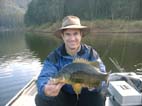Hi from Australia. I will be writing a monthly article
about the Bass (Macquaria novemaculeata) fishing in Australia,
so I will introduce myself, and my fishing experiences.
My name is Michael Bell and I have lived on the Gold Coast Queensland
for the last 10 years, prior to that I live in central New South Wales.
I have been fishing for as long as I can remember, my father and grandfather
taught me the basics of fishing. We would fish at least once a month,
casting and trolling lures for, Yellowbelly (Macquaria ambigua)
and Murry cod (Maccullochella peelii peelii )and trout.
I moved to The Gold Coast in 1992 after traveling throughout Europe and
Indonesia. The Gold Coast is located 80 kilometers south of Brisbane and
has an excellent range of fishing opportunities, including deep see fishing,
chasing Marlin, tuna, Wahoo, Spanish mackerel and a host of others, to
estuary fishing, Trevally, bream, flathead, and whiting can be caught
on a regular basis. I really enjoy salt-water fishing but the Freshwater
fishing is my real field of expertise. It was through a tackle shop that
I was introduced to the Australian Bass Association. I joined the Association
in 1997, the association is a group of sports minded fisherman dedicated
to the preservation of Australian Bass, and specialize in freshwater fishing.
It was through this organization I was able to meet people with similar
interest and learn new techniques to catch Australian Bass.
Australian Bass is a different species from big mouth and small mouth
bass. They do however have several things in common, they take lures and
fight hard, are both stocked in waterways and are highly prized amongst
anglers.
Australian bass natural habitat is coastal rivers and streams on the
eastern coast of Australia, as far north as Tin Can Bay in Queensland
and as far south as Gippsland in Victoria. Bass inhabit rivers and streams
from the top waters right through to brackish waters in the coastal strip.
Unlike big mouth Bass, Australian bass spawn in brackish water early
spring dependant on water levels and salinity.
The size of Australian bass is considerably smaller than American big
and small mouth bass. A good-sized bass is around 40cm and can weigh around
1kg. The largest I have ever caught was a 53cm bass. I have seen pictures
of Australian bass up to 60cm and listened to fishing stories of 70cm
bass lost at the boat, but they remain stories.
The home of Australian bass several years ago was "the gorge",
this is a natural river system some 300 km long extending from Grafton
right through to the costal town of Coffs harbor. Due to fishing pressure
by anglers and professional fisherman using nets the bass population was
in danger only 10 short years ago.
The department of primary industries fisheries allocated money for the
breeding and stocking of local lakes.
No one knew how successful it would be and for a few years it was even
criticized due to amount of money used to research the Bass breeding cycle
and to replicate breeding conditions. Australian Bass cannot breed in
the lakes and restocking needs to be carried out ever year. Money to stock
lakes is by stocking associations, such as the Australian Bass Association
and local fishing groups.
Recently a fishing license was introduced in Queensland, where a percentage
of money raised would be used to stock lakes and waterways (and is working
nicely). Now the home of Australian bass could be one of many stocked
lakes throughout the east coast of Australia. The Best lakes would have
to be Summerset, Maroon, Glenbourne and Borumbar. There are so many lakes
within a few hours drive of Gold Coast, I would say the home of bass is
now South East Queensland.

Bass fishing equipment.
The fishing gear used on the Australian bass is very similar to small
mouth bass fishing. Rods range from finesse 2kg spin rods for soft plastics
right up to 8kg bait casting outfits for throwing heavy spinner baits.
In Australia for the last few years braided and fused line has been the
most popular due to its fine diameter and strength, using a fluorocarbon
or mono leader of a rod length or so to finish it off.
Lures most commonly used on Australian bass are very similar to big and
small mouth bass. The Australian bass are very aggressive fish and will
attach anything that moves. Spinner baits would probably be the most widely
used lure, followed by an array of hard bodied suspending, diving, lipless,
surface, and the very popular soft plastics baits. Fly fishing for Australian
Bass is another way to target this species, several anglers on the Australian
Bass Pro tour specialize in this technique and for the last two years
have won several events, Including a grand final.
In the next few months I will be going to a few remote locations in search
of wild bass, through the Australian Bass association we will be surveying
rivers and lakes to get an estimate on fish stocks. Until next time enjoy
your fishing and I hope you catch a few.
●If you wish to mail him directly, :
mikey@fishing.onthenet.com.au
●Interested in A.B.A.(Australian Bass Association)?:
www.fishing.onthenet.com.au
↓Click to enlarge↓
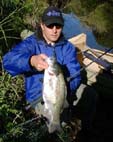
![]()
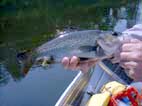
![]()
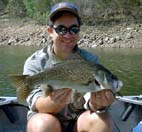
![]()
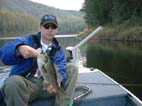
![]()
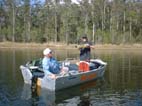
![]()

![]()
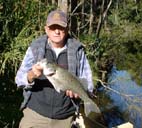
![]()
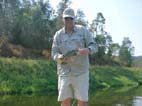
![]()

![]()

![]()

![]()
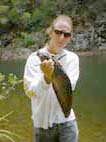
![]()
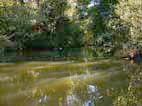
![]()
